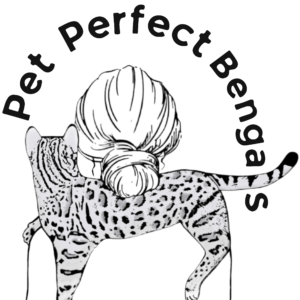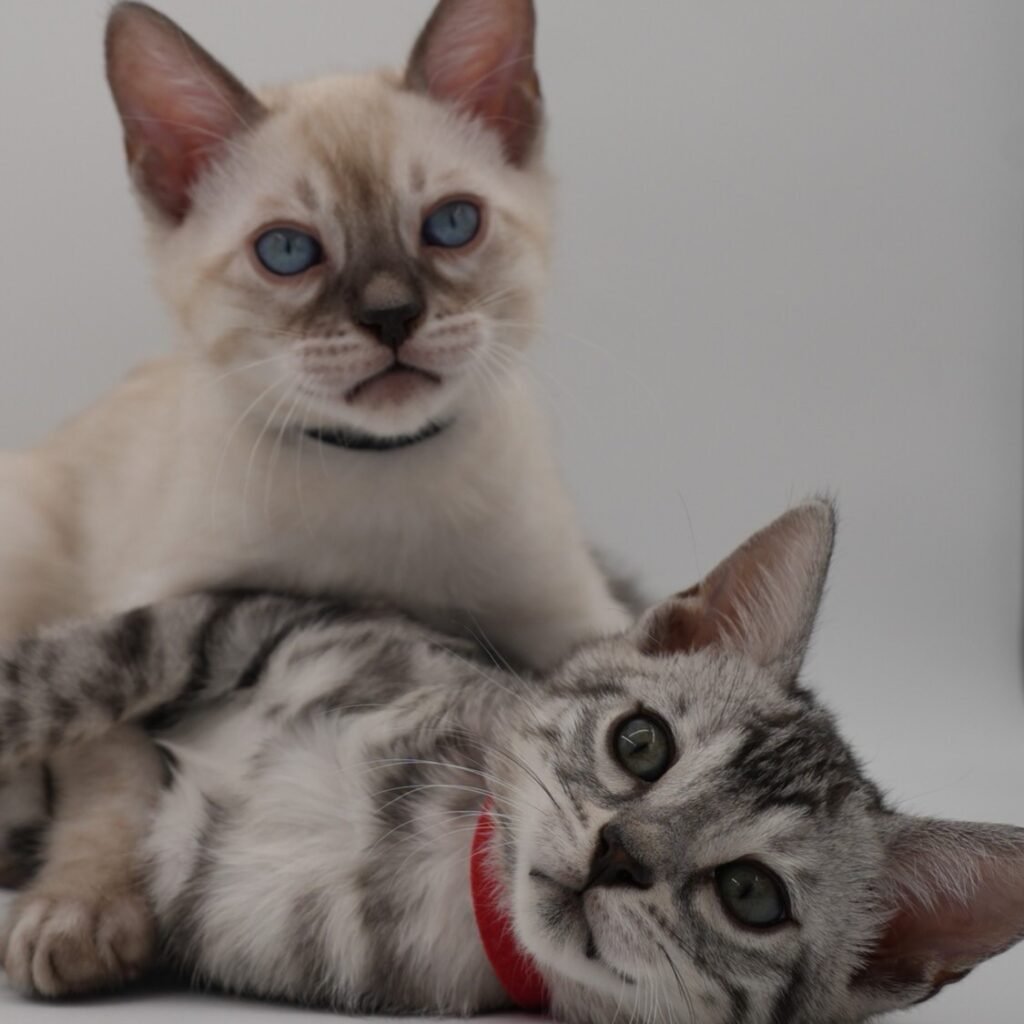
Punnett Squares & Genetics
Genetics, the study of how traits pass from parents to offspring, plays a crucial role in Bengal cats, influencing their coat color, pattern, health, and temperament. At Pet Perfect Bengals, we apply this knowledge to carefully select high-quality breeding cats, enhancing desirable traits in each generation. We’re excited to introduce you to Bengal color genetics, where you’ll learn about various coat colors and patterns, their genetic influences, and inheritance patterns. You’ll also discover how Punnett squares help predict offspring traits. This exploration will deepen your appreciation for the genetic artistry behind these stunning cats, unraveling the fascinating science that makes Bengals truly special.
- Gene: The fundamental unit of heredity, composed of DNA, that is passed from parents to offspring. Genes determine specific characteristics or traits in an organism.
- Allele: Alternative forms or variants of a gene that can occur at a specific location (locus) on a chromosome. Alleles come in two main types
- Inheritance Patterns: The way genetic traits are passed from parents to offspring and how different types of allele interactions influence trait expression.
- Dominant: Expressed when present in either one or both copies. Typically represented by uppercase letters (e.g., B).
- Recessive: Expressed only when present in two copies (homozygous). Typically represented by lowercase letters (e.g., b).
- Codominance: When both alleles in a gene pair are equally expressed, resulting in a blend or mixture of traits.
- Incomplete dominance: When one allele is not completely dominant over the other, resulting in an intermediate phenotype.
- Zygosity: Refers to whether the alleles for a specific gene inherited from both parents are identical or different.
- Heterozygous: Having two different alleles for a particular gene (e.g., Bb).
- Homozygous: Having two identical alleles for a particular gene (e.g., BB or bb).
- Geno/Phenotype: The relationship of an organism’s genetic code and their outward appearance or traits.
- Genotype: The specific genetic makeup of an organism, defined by the combination of alleles they carries for a particular gene or set of genes.
- Phenotype: The observable characteristics or traits of an organism, resulting from the interaction of their genotype with environmental factors.
- Melanin: The primary pigment responsible for coat color in cats. Two main types:
- Pheomelanin: Produces yellow to red pigmentation.
- Eumelanin: Produces brown to black pigmentation.
Comprehensive Allele List
Bengal cats inherit two alleles for each gene, one from each parent. This comprehensive gene list outlines key genes and alleles that affect a Bengal cat’s coat. It provides a valuable reference for breeders and Bengal enthusiasts to understand and predict the diverse range of colors and patterns found in the breed.
Brown alleles
- B: Wild-type Black/Brown (dominant)
- b: Chocolate (recessive to B, dominant to b1)
- b1: Cinnamon (recessive)
Silver alleles
- I: Inhibitor (dominant)
- i: Non-inhibitor (recessive)
Snow Alleles
- C: Wild type, Full color (dominant)
- cs: Colorpoint Siamese (recessive to C, incomplete dominant to cb)
- cb: Colorpoint Burmese (recessive to C, incomplete dominant to cs)
To learn more visit Snow Bengal Cat
Dilute (Blue) Alleles
- D: Wild type, full color (dominant)
- d: Dilute (recessive)
Agouti (Black) Alleles
- A: Agouti variant, Domestic Cat (dominant)
- a: Non-agouti variant, Domestic Cat (recessive to A, incomplete dominant to APb)
- Apb: Agouti variant, Asian Leopard Cat (recessive to A, incomplete dominant to a)
To learn more visit Black Bengal Cats
Punnett Squares and how they work
A Punnett square is a straightforward grid tool used to predict the potential genotypes of kittens from specific pairings. It is especially valuable for determining the likelihood of inheriting certain coat colors, such as brown, silver, or snow. Moreover, when genetic testing identifies an allele for a disease carried by a potential parent, breeders can use a Punnett square to assess the risk of these diseases in offspring, thereby enabling more informed decisions in their breeding programs.
In the following example we use the Brown Gene to demonstrate how to create a Punnett square. In this example parent one is a Brown/Black Bengal that carries cinnamon and parent two is a chocolate Bengal that carries cinnamon.
BROWN GENE
Parent one: B/b1
(Black/Brown caries Cinnamon)
Parent two: b/b1
(Chocolate caries Cinnamon)
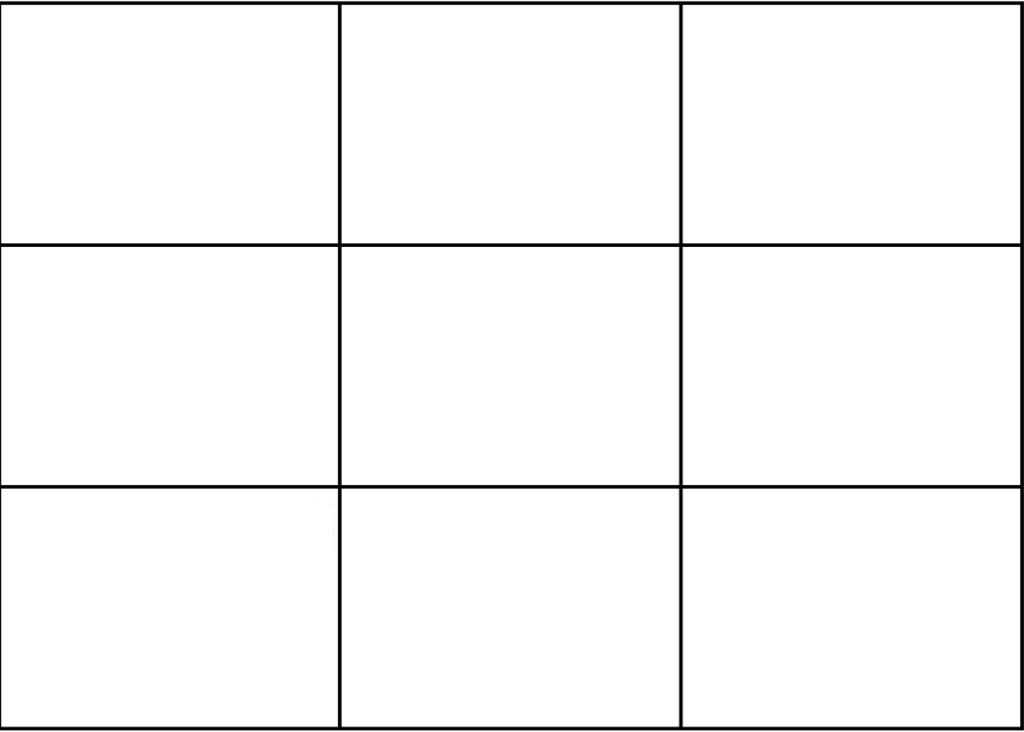
Step one: Draw a grid with three rows of three squares .
Step two: Write the alleles from one parent across the top and the alleles from the other parent down the side.
Step three: Combine the alleles from the top and side in each square to see all possible genotypes for the offspring.
This paring would likely result in 25% of the kittens being Black/Brown caring cinnamon (B/b1), 25% being Black/Brown caring chocolate (B/b), 25% cinnamon (b1/b1), and 25% being chocolate caring cinnamon (b/b1).
Lets Get Complicated
The previous example explored how a punnett square works for a single gene. However, Bengals possess a complex genetic makeup where multiple genes interact to determine their distinctive traits. In the following scenario, we will take the same pairing and examine a more detailed genetic combination. Parent One is a Silver (I/I) Blue (d/d) Bengal that carries Cinnamon (B/b1) and Colorpoint Siamese (C/cs) Parent Two is a Twilight Charcoal (Apb/Apb) Chocolate Bengal that carries Cinnamon (b/b1) and Colorpoint Siamese (C/cs)
Parent One: B/b1, I/I, C/cs, d/d A/A (Silver Blue carries Cinnamon and Colorpoint Siamese)
Parent Two: b/b1, i/i, C/cs, D/D, Apb/Apb (Twilight Charcoal Chocolate carries Cinnamon and Colorpoint Siamese)
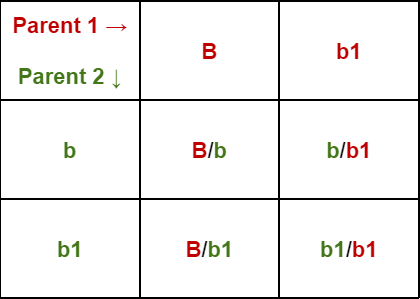
25% – B/b
25% – B/b1
25% – b/b1
25% – b1/b1
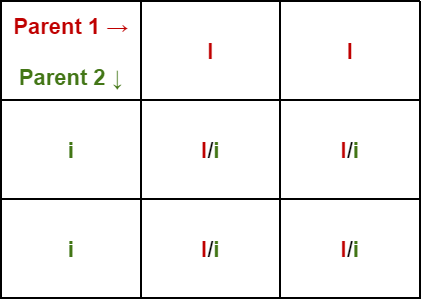
100% – I/i
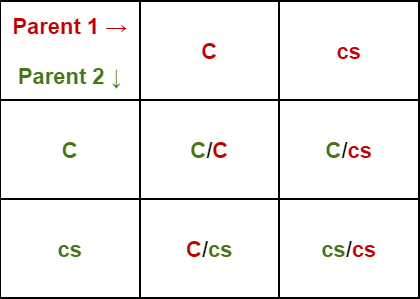
25% – C/C
50% – C/cs
25% – cs/cs
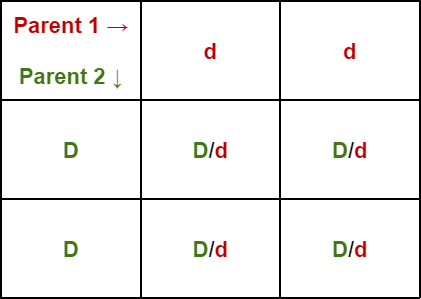
100% – D/d

100% – A/Apb
0.25 (B/b) x 1.00 (I/i) x 0.25 (C/C) x 1.000 (A/Apb) x 1.00 (D/d) = 0.0625 or 6.25% (B/b, I/i, C/C, D/d, A/Apb)
0.25 (B/b) x 1.00 (I/i) x 0.50 (C/cs) x 1.000 (A/Apb) x 1.00 (D/d) = 0.125 or 12.5% (B/b, I/i, C/cs, D/d, A/Apb)
0.25 (B/b) x 1.00 (I/i) x 0.25 (cs/cs) x 1.000 (A/Apb) x 1.00 (D/d) = 0.0625 or 6.25% (B/b, I/i, cs/cs, D/d, A/Apb)
0.25 (B/b1) x 1.00 (I/i) x 0.25 (C/C) x 1.000 (A/Apb) x 1.00 (D/d) = 0.0625 or 6.25% (B/bl, I/i, C/C, D/d, A/Apb)
0.25 (B/b1) x 1.00 (I/i) x 0.50 (C/cs) x 1.000 (A/Apb) x 1.00 (D/d) = 0.125 or 12.5% (B/bl, I/i, C/cs, D/d, A/Apb)
0.25 (B/b1) x 1.00 (I/i) x 0.25 (cs/cs) x 1.000 (A/Apb) x 1.00 (D/d) = 0.0625 or 6.25% (B/bl, I/i, cs/cs, D/d, A/Apb)
0.25 (b/b1) x 1.00 (I/i) x 0.25 (C/C) x 1.000 (A/Apb) x 1.00 (D/d) = 0.0625 or 6.25% (b/bl, I/i, C/C, D/d, A/Apb)
0.25 (b/b1) x 1.00 (I/i) x 0.50 (C/cs) x 1.000 (A/Apb) x 1.00 (D/d) = 0.125 or 12.5% (b/bl, I/i, C/cs, D/d, A/Apb)
0.25 (b/b1) x 1.00 (I/i) x 0.25 (cs/cs) x 1.000 (A/Apb) x 1.00 (D/d) = 0.0625 or 6.25% (b/bl, I/i, cs/cs, D/d, A/Apb)
0.25 (b1/b1) x 1.00 (I/i) x 0.25 (C/C) x 1.000 (A/Apb) x 1.00 (D/d) = 0.0625 or 6.25% (bl/bl, I/i, C/C, D/d, A/Apb)
0.25 (b1/b1) x 1.00 (I/i) x 0.50 (C/cs) x 1.000 (A/Apb) x 1.00 (D/d) = 0.125 or 12.5% (bl/bl, I/i, C/cs, D/d, A/Apb)
0.25 (b1/b1) x 1.00 (I/i) x 0.25 (cs/cs) x 1.000 (A/Apb) x 1.00 (D/d) = 0.0625 or 6.25% (bl/bl, I/i, cs/cs, D/d, A/Apb
The Calculator
Manually calculating genetic probabilities can be time-consuming and prone to error, especially with complex gene interactions. That’s why we developed the Genetic Calculator for Kittens, a tool designed to instantly and accurately determine the all probable genotypes of kittens based on the parents’ genetics. This calculator not only saves time but also eliminates human error, providing clear and user-friendly results. It’s an indispensable resource for breeders and cat enthusiasts seeking reliable, repeatable outcomes without the challenges of manual calculations.

